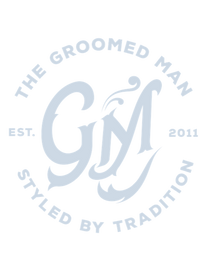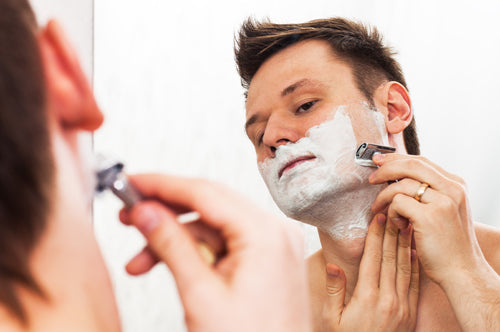Essential Tools for Traditional Wet Shaving
Please note that when we talk about traditional wet shaving, we are talking about a single-blade manual razor. Not a cartridge razor such as Mach 3 or an electric razor.

We will look at the double-edge safety razor. The cutthroat or straight razor is a specialist razor used by barbers, so is not recommended for beginners.
The double-edge razor has a handle, a head, and a disposable double-edge metal blade. The entire razor is metal, so it can be recycled. Additionally, there are different colours and types of grip on the handle, so it is best to look at a few before you decide upon your razor.

When wet shaving, some form of lubrication is desirable, as it helps the blade to glide across the skin easily, preventing tugging and shaving rashes.
With traditional wet shaving, we recommend you use either a cream or soap.
Cream
A shaving cream will produce a thick traditional lather, helping you get a smooth shave. It can be applied with or without a brush. Additionally, cream often has added ingredients to help the skin stay soft and moisturised, so no extra moisturisers are needed.
Soap
A soap will produce a lather like cream but will take more effort. It is ideal to use a shaving brush even if this is an extra expense. If you are looking for a 100% natural product or one suitable for vegans, soaps have a much wider range of options than shaving creams.
3 – The brush

A shaving brush is an optional extra, but can make producing a thick creamy lather easier. Traditionally, a good quality shaving brush that absorbs water well, was made from badger hair. Recently, however, synthetic hair brushes have become much better. There are many different styles, colours and sizes available, starting from under £10.00. A drip stand is also recommended, these are used to hang your brush and allow your brush to drip dry, helping prolong the life of the brush.
4 – Styptic pencil
If you are new to shaving or have a dull blade you may get the occasional cut or nick. The styptic pencil is both antiseptic and astringent so dab it on to help the healing process.
5 – Shaving bowl
If you are using shaving soap then having a bowl is an essential piece of equipment. Often you can buy a shaving bowl and soap together to get you started, then buy refills when you run out of soap.
6 - Pre-Shave Oil (Optional)
Pre-shave oil adds an extra layer of protection and helps soften your beard before applying shaving cream or soap. This is especially useful for people with sensitive skin.
7 – Aftershave

Step-by-Step Shaving Process
1. Preparation

Use warm water and a gentle cleanser to remove dirt and oil. Wet shaving works best on clean skin.
Soften Your Beard
You can do this by shaving right after a hot shower or by applying a warm, damp towel to your face for a few minutes. This softens the hair and opens the pores.
2. Lathering
We recommend that you use a brush as you get a better result, but you can use your fingertips.
Wet the Brush
Soak your shaving brush in warm water for a few minutes. Shake off the excess water so the brush is damp, not dripping.
Load the Soap
Swirl the damp brush on your shaving soap or dip it in shaving cream for about 10- 20 seconds until you get a good load on the brush.
Build the Lather
You can build the lather on your face or in a shaving bowl. Use circular motions to create a thick, creamy lather.
3. Shaving

Hold the razor correctly
Hold your razor at around a 30-degree angle to your face. Let the weight of the razor do the work; don’t apply too much pressure.
First Pass (With the Grain)
Shave in the direction your hair grows (with the grain) using short, light strokes. Rinse the blade frequently.
Re-Lather
After the first pass, reapply the lather.
Second Pass (Across the Grain):
For a closer shave, shave across the grain (perpendicular to the direction your hair grows)
4. Rinsing and Aftercare
Rinse Your Face Wash off any remaining lather with cold water to close the pores.
Apply Aftershave
Apply an aftershave balm or splash to soothe and protect your skin.
Clean Your Equipment
Rinse your razor and brush thoroughly and let them air dry.
Tips for a Better Shave
Start Slowly
Take your time when learning to use a razor. Rushing can lead to nicks and cuts.
Don’t Apply Pressure
The weight of the razor should be enough to cut the hair. Pressing too hard can cause irritation.
Use Short Strokes
Long strokes can increase the likelihood of cutting yourself or missing spots. Short, controlled strokes give you more precision.
Experiment with Blades
Not all blades are the same. You might need to try a few different brands before finding the right one for your skin and hair type.
Take Care of Your Skin
Shaving can be harsh on your skin. Moisturise regularly and use products that suit your skin type.
Common Mistakes to Avoid
Shaving Too Fast
Traditional wet shaving is a process that requires patience. Rushing through it can result in cuts and irritation.
Skipping Pre-Shave Preparation
Skipping the step of softening your beard and cleansing your face can lead to a rougher shave and more irritation.
Using Dull Blades
Always use a sharp blade. Dull blades tug at the hair instead of cutting it, leading to discomfort and razor burn.
Neglecting Aftercare
Aftershave isn’t just about smell. It helps close pores, reduce irritation, and prevent infections.
Benefits of Traditional Wet Shaving
Cost-Effective
While the initial investment in equipment might seem high, the long-term costs are significantly lower. Razor blades are much cheaper than disposable cartridge razors.
Eco-Friendly
Traditional wet shaving produces less waste than modern shaving methods since you only dispose of the blade, not entire cartridges or plastic handles.
Closer Shave
With practice, you can achieve a closer and smoother shave than with modern multi- blade razors.
Enjoyable Experience
Many people find the process of traditional wet shaving relaxing and satisfying. It turns a daily chore into a ritual.
Conclusion
Traditional wet shaving may take a bit more time and practice, but the results are well worth it. By investing in quality tools and following the proper technique, you’ll enjoy a closer, more comfortable shave. Plus, it’s a great way to slow down and take some time for yourself.


